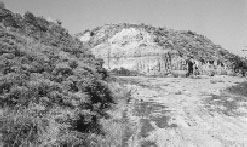|
|
|
| Contact Us Membership School Programs Fireless Chats Bluff Lake Articles | |
| Volunteer Programs Map to Bluff Lake Supporters Photo Gallery Home | |


Noted
Eco-System Expert Finds Bluff Lake
“Quite A Little Jewel”
The river doctor has taken the pulse of Bluff Lake and the prognosis is good. Kathy Flanagan, a world-renowned expert in wetlands and rivering systems, recently toured Bluff Lake and delivered (June 15) a “fireless chat”; about her findings.
“Bluff Lake is quite a unique wetland area,” said Flanagan, a consultant in eco-system restoration, during a recent interview. “You have quite a little jewel.”
Top on Flanagan's list of good things at Bluff Lake are the “multiple generations” (some old, some new) of cottonwoods. Cottonwood populations indicate the area has been flooded out from time to time, allowing Bluff Lake to occasionally re-connect to nearby Sand Creek.
The cottonwoods are critical, she adds, to provide habitat
for wildlife, hold the soil along the banks, and offer  shade
for plant seedlings. They're also a remnant population, to a much larger
deciduous forest and riparian habitat that was found throughout Colorado.
shade
for plant seedlings. They're also a remnant population, to a much larger
deciduous forest and riparian habitat that was found throughout Colorado.
Bluff Lake also includes “flood chutes” around the lake. These are the small channels on the flood plain which fill with water first when the creek floods. Other attributes include the tree islands and natural levees, which support thriving populations of herons, hawks, cattails, sedges and amphibians.
“Amphibians are having a really hard time right now,” Flanagan pointed out. “There is an alarming extinction rate with amphibian species. Wetlands are at a critical crossroads.”
Flanagan should know. She holds a master's degree and doctorate in geology, as well as two bachelors degrees — one in anthropology and one in geology. Flanagan is an expert in sendimentology and has studied paleo-ecological issues around the world, in countries like Pakistan and Africa. Much of her time has been spent in southern Illinois but she's also looked at ancient rivering and wetland systems along the Front Range.
A rivering system includes channels, floodplains, and wetlands areas; studying the system includes looking at the cycle of flooding and drying, along with the resulting movement of sediment. “All eco-systems are dependent on the relationship between water flows and sediment,” she says.
Flanagan guesses that the Bluff Lake we know today is the result of a “large meander” in a much larger ancient stream. The prairie-based eco-system shows it was built by prairie run-off (not alpine run-off) when the Denver basin dropped down as the mountains were formed.
Copyright 2000 Bluff Lake Nature Center
Design by Jody Chapel
Hosted by Ecentral, Inc.
